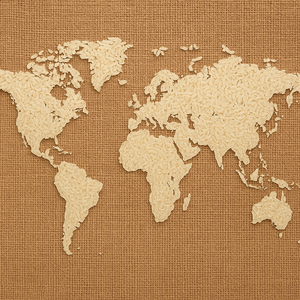Rice is much more than just a food: it is an ancient crop, an agricultural tradition, a symbolic ingredient present in the kitchens of almost every corner of the planet.
Thinking of rice as a “local” product is misleading: in reality, it is one of the most cultivated and consumed cereals in the world , with a global relevance that few other agricultural products can boast.
An agricultural giant: 165 million hectares cultivated
In the world, rice is cultivated on approximately 165 million hectares . Of these, approximately 89% is found in Asia , confirming its importance in the Eastern food culture, where it represents the daily basis of the diet.
Suffice it to say that over 60% of the world's population regularly eats rice: a fact that speaks for itself. It is not just a food, but a fundamental pillar of global food security.
And in Europe? Just a small grain in the haystack
In Europe, however, the areas cultivated with rice are extremely limited: just 650,000 hectares , or less than 1% of the world total. The reason is mainly climatic: rice is a plant that grows in tropical and subtropical environments, and only some varieties adapt to European latitudes.
Yet, despite this small area, Europe produces very high quality rice, appreciated throughout the world, and Italy is its beating heart.
Italy, protagonist of European rice cultivation
With approximately 230,000 – 250,000 hectares cultivated every year , Italy is the leading European rice producer, covering 46% of EU production alone .
The most suitable regions are Piedmont and Lombardy , where the rice-growing tradition has its roots in the centuries and is combined with ideal soil and climate conditions. Other regions such as Emilia-Romagna, Veneto, Sardinia, Calabria and Sicily contribute with smaller but equally valuable productions.
Two souls of rice: Indica and Japonica
There are over 140,000 varieties of rice in the world, but they all come from two main families:
- Indica , with long, tapered and light grains, grown mainly in warm climates (Asia, Africa, Latin America).
- Japonica , with shorter and rounder grains, suitable for more temperate climates, typical of Europe, Japan and Korea.
The Indica variety represents approximately 90% of global production , while Japonica covers the remaining 10%.
One global food, many different cuisines
Rice takes on a thousand forms and meanings depending on where it is grown and cooked:
- In India and Thailand , fragrant and spicy.
- In Japan , it is the basis of sushi culture.
- In Spain , it is the star of paella.
- In Italy , it becomes creamy and enveloping in our risottos.
Every culture has adopted and reinterpreted it, transforming a simple ingredient into a local gastronomic symbol.
A sustainable crop (if managed intelligently)
Not everyone knows that rice is one of the few plants capable of growing in submerged conditions , thanks to a particular internal structure that allows it to transport oxygen from the leaves to the roots. This allows it to compete effectively with weeds, reducing the need for chemical herbicides , and to adapt even to less favorable climates.
Furthermore, waste from rice processing, such as husks and chaff , are increasingly used in the circular economy : green building, sustainable packaging, green energy.
A future to be rewritten: quality, awareness, culture
Rice is part of the agricultural history of the world, but too often it is taken for granted. Promoting this product means telling its origin, biodiversity, the effort of cultivation , but also its ability to create bridges between different cultures.
It is precisely in this direction that we at laBalocchina want to go: to spread the culture of rice, to promote its conscious and sustainable use, and to rediscover the value of a food as simple as it is extraordinary.
After all, every grain has a story to tell.

